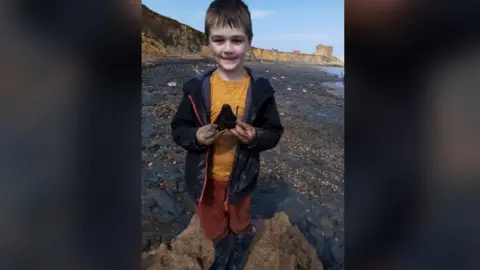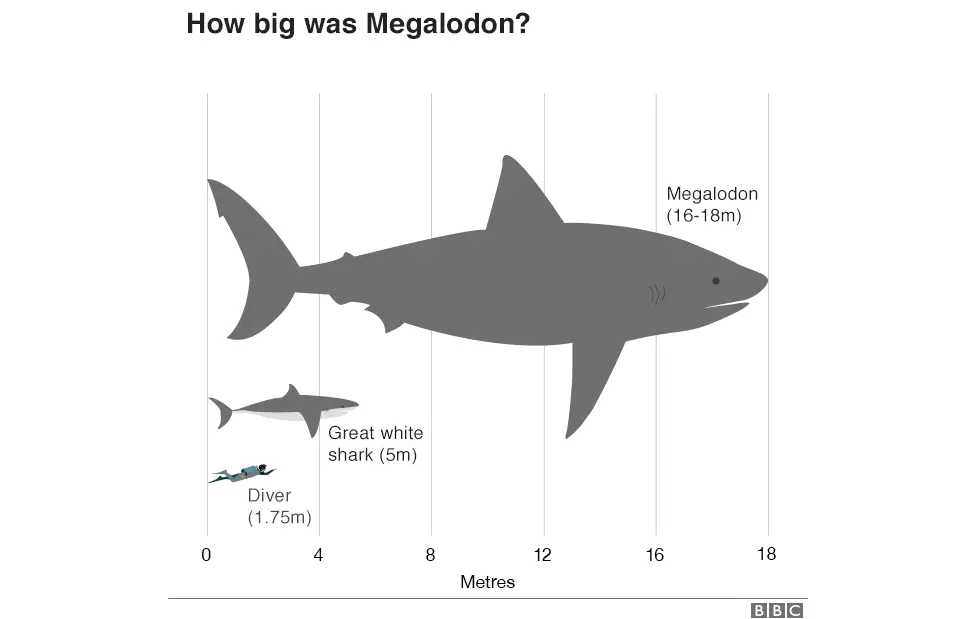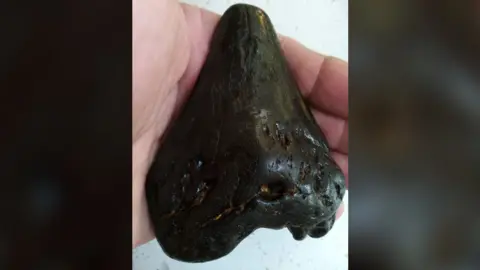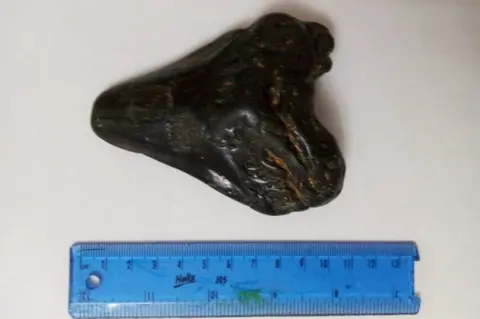Boy, six, finds giant megalodon shark tooth on Bawdsey beach
A six-year-old boy has found a shark tooth belonging to a giant prehistoric megalodon that could be up to 20 million years old.
Sammy Shelton found the 10cm-long (4in) tooth on Bawdsey beach in Suffolk during a bank holiday break.
It has been confirmed as belonging to a megalodon - the largest shark that ever existed - by expert Prof Ben Garrod.
His dad Peter Shelton said Sammy was sleeping with it near his bed as he was "very attached to it".
The pair, from Bradwell near Gorleston-on-Sea in Norfolk, were searching for fossils when they came across the giant shark's tooth, as first reported in the Great Yarmouth Mercury.
"Sammy was very excited as we'd seen fragments of shark teeth on the beach, but nothing as big and heavy as this," Mr Shelton said.
 Getty Images
Getty Images Peter Shelton
Peter SheltonPhotographs of the find were sent to Prof Garrod, a broadcaster and evolutionary biologist at the University of East Anglia in Norwich.
"It belonged to a megalodon, the largest ever shark - and its teeth are not often found around the UK coastline," he said.
"Maybe just a handful a year, but this is a particularly good example, in really good condition, whereas they are usually quite worn when found."

The megalodon could grow up to 18m (60ft) in length, scientists estimate, and weigh up to 60 tonnes, he said.
Dwarfing anything else swimming in the waters at the time, these were "specialist whale eaters - they were ambush hunters," Prof Garrod said.
 Peter Shelton
Peter SheltonThe megalodon dominated all the seas around the world other than those parts of the oceans surrounding Antarctica.

The megalodon
- The cartilaginous fish (whose skeleton is made of cartilage rather than bone) was a carnivore and had no known predators
- It could eat anything it liked, but its favourite food was whales, although seals would also have been on the menu
- Most of this shark's hunting was in the open sea (juveniles lived closer to shore) and it attacked its prey near the surface, when it came up for air
- Megalodon could swim at high speed in short bursts so tended to rush its prey from beneath
- It would first aim to disable its prey by injuring a flipper or the tail, then once unable to swim properly, the victim would be easy to finish off
- Lived from about 20 million years ago, long after the dinosaurs became extinct 65 million years ago
Source: BBC Science

The name means "big tooth" and the giants were active from about 22 million years ago until about three million years ago when they became extinct.
Sammy's find was "a really big thing" for the little boy, Prof Garrod said.
"Not many people who look for a megalodon tooth actually find one," he said.
"I know - I've been searching since I was a child and I knew all the beaches around the area - but I still haven't found my megalodon."
 Peter Shelton
Peter SheltonSammy's excitement has been shared with his friends at school, and he took the tooth to his beaver cubs group, after which he was awarded his explorer badge, his father said.
Sammy described the "massive" tooth as his best-ever find, and said it was just lying there on the sand and pebbles.

Find BBC News: East of England on Facebook, Instagram and Twitter. If you have a story suggestion email [email protected]
